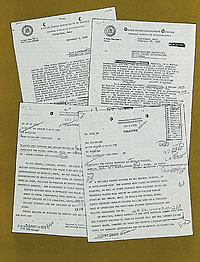 |
 |
 |
||||
 |
|
 |
|
 |
|
A Campus Reacts (1970-2003) 1970 — OAM reports that in the wake of the Kent State shootings, Oberlin’s graduating seniors voted to eliminate caps and gowns in an attempt to recognize “a time of extraordinary tension.” Time, Newsweek, and other national media carry wire photos of the academic procession.
1976 — OAM Editor Phil Tear muses as to why fewer than 25 percent of alumni contributed to the previous year’s Annual Fund. The major reason, he concludes, is a firm belief by graduates that Oberlin does not need money. 1978 — 1971 graduate Toby McIntosh writes an article revealing that the FBI regularly monitored civil rights and anti-war demonstrations at Oberlin from 1960 to 1975. Through the Freedom of Information Act, McIntosh obtained more than 400 pages from the FBI, which encompassed 71 separate reports and the names of 52 Oberlinians. 1979 — OAM begins printing essays from alumni urging the College to withdraw its investments in corporations doing business in South Africa. 1981 — A cover story on the release of the U.S. hostages in Iran mentions the manager of the Oberlin Inn, whose sister-in-law was among the 52 prisoners.
1985 — OAM prints Oberlin’s newly adopted South African investment policy, along with essays by five Oberlinians about how Oberlin should work toward ending apartheid. 1991 — In a piece titled “Touched by AIDS,” 18 alumni share their personal experiences with the now worldwide epidemic. The first-person accounts, written by health educators, family members, or individuals diagnosed with HIV, is widely praised by readers. 1993 — OAM interviews Emmy-award winning television director Jim Burrows ’62, co-creator of Cheers, the 11-year sitcom whose final episode in 1992 was the second most-viewed show in television history. “We were all friends,’ Burrows says of the show’s cast and crew. “We poured our hearts and souls into that show.” 1994 — Oberlin is one of the best places in the world to view the solar eclipse of May 10. “The eclipse had a noticeable effect on the local population, creating a sense of camaraderie and lightheartedness,” writes OAM. 1997 — OAM covers the October rededication of the renovated Peters Hall. “Stalwart, massive, majestic, indestructible—Peters Hall has impassively weathered every change the College has witnessed during the last 110 years. The silent, watchful rock giant towering over the campus is ready to welcome within its stone embrace generations of students to come.” 2000 — An article titled “The Green Machine” introduces readers to the just-completed Adam Joseph Lewis Center for Environmental Studies. The building’s dedication in September is marked by a symposium drawing the nation’s most noted environmental thinkers. “If this building were the Kitty Hawk, we’re 10 feet off the ground,” says Oberlin Professor David Orr. “Someday, someone will design 747s.” 2001 — In the aftermath of September 11, OAM seeks out alumni in key political, public health, and foreign policy positions, including former WHO leader DA Henderson ’50, who, in the midst of new anthrax scares, is appointed director of the Center for Public Health Preparedness. Foreign policy experts Richard Haass ’73, Steven Mann ’73, and Paula Newberg ’74 comment on the challenges facing the region and U.S. response. 2003 — As the nation commemorates the 100th anniversary of flight, OAM runs a cover story on alumna Katharine Wright Haskell, sister of Orville and Wilbur Wright, whose contributions to the brothers’ success have only recently come to light. Next Page >> |
 1972 — Pete Seeger is chosen by graduating seniors to deliver the Commencement “presentation” via banjo, guitar, songs, and personal comments. OAM carries excerpts: “To my mind the important thing happening now is that people everywhere in the world, including here, are finally realizing there’s no more place to run to. We’re either going to solve our problems, or they’re going to solve us.” Seeger refuses to accept an honorary degree.
1972 — Pete Seeger is chosen by graduating seniors to deliver the Commencement “presentation” via banjo, guitar, songs, and personal comments. OAM carries excerpts: “To my mind the important thing happening now is that people everywhere in the world, including here, are finally realizing there’s no more place to run to. We’re either going to solve our problems, or they’re going to solve us.” Seeger refuses to accept an honorary degree. 1984 — Having read a newspaper account of Oberlin’s 150th anniversary conference on the education of black Americans, Bill Cosby telephones President Fred Starr with an offer to perform a free, one-man show to raise scholarship funds for minority students. “President Starr retained enough outward calm to accept Cosby’s offer, and arrangements were made for a performance at the Kennedy Center for the Performing Arts,” writes OAM.
1984 — Having read a newspaper account of Oberlin’s 150th anniversary conference on the education of black Americans, Bill Cosby telephones President Fred Starr with an offer to perform a free, one-man show to raise scholarship funds for minority students. “President Starr retained enough outward calm to accept Cosby’s offer, and arrangements were made for a performance at the Kennedy Center for the Performing Arts,” writes OAM.